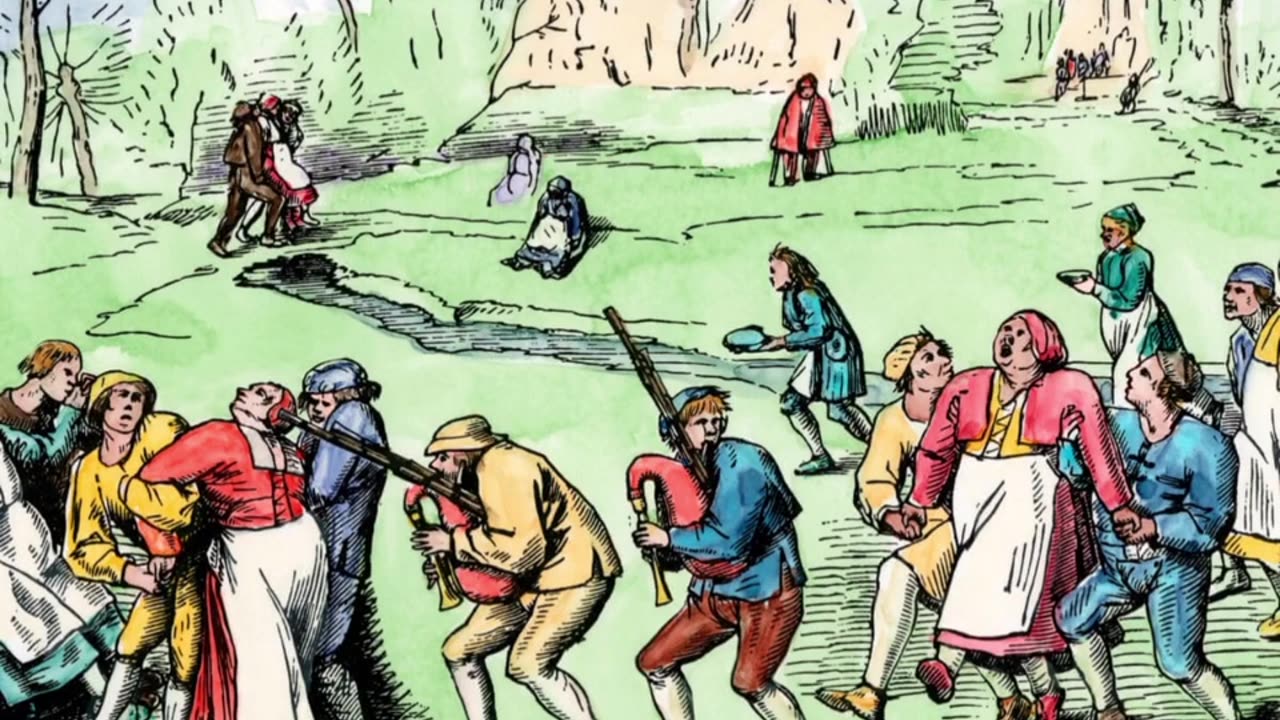Premium Only Content

The Dancing Plague of 1518: People danced uncontrollably in the streets of Strasbourg for days
The history books are filled with fascinating events, but few are as baffling and intriguing as the Dancing Plague of 1518. In the summer of that year, the city of Strasbourg, located in present-day France, was gripped by a bizarre phenomenon. Suddenly, seemingly without reason, people began to dance uncontrollably in the streets. This strange event, which lasted for days and even claimed lives, has puzzled historians and medical experts for centuries. In this article, we delve into the details of the Dancing Plague, exploring its causes, its impact on the population, and the lasting impact it had on society.
The Unexplained Outbreak
It all began when a woman named Frau Troffea stepped onto the streets of Strasbourg and started to dance. This may seem like an innocent and ordinary act, but what followed was far from it. Frau Troffea danced for hours, seemingly unable to stop. Strasbourg's residents were perplexed, but little did they know that this was just the beginning. Within a week, more than 30 people had joined in the strange dance, and within a month, the number had grown exponentially.
The Epidemic Spreads
The dancing epidemic quickly spread through Strasbourg, with hundreds of people being affected. Witnesses reported that those afflicted would dance from sunrise to sunset, often collapsing from exhaustion only to resume dancing the next day. The uncontrollable dancing caused both physical and mental torment for the dancers. Some were said to have suffered heart attacks, strokes, or even death from sheer exhaustion. Yet, despite the suffering and fatalities, the dancing continued.
Theories and Explanations
To this day, the true cause of the Dancing Plague of 1518 remains unknown. Numerous theories have been proposed, ranging from psychological explanations to supernatural causes. One theory suggests that the dancers were part of a religious sect that used dance as a form of worship. Another suggests that the dancers were poisoned by a toxic fungus, such as ergot, which can cause hallucinations and involuntary muscle movements. However, these theories have their flaws and fail to fully explain the extent and scale of the epidemic.
Mass Hysteria or Contagion?
One prevailing theory that holds some weight is the idea of mass hysteria. Mass hysteria is a phenomenon in which a group of people collectively exhibit symptoms of an illness or disorder that has no underlying organic cause. In the case of the Dancing Plague, it is believed that the initial case of Frau Troffea was the catalyst that triggered a contagious psychological reaction in the population. As more and more people saw others dancing, they too succumbed to the compulsion to dance, creating a vicious cycle.
Socioeconomic Factors
Another important aspect to consider is the socioeconomic context of 16th-century Europe. Strasbourg was plagued by poverty, famine, and disease at the time of the outbreak. Many inhabitants of the city were socially marginalized and endured harsh living conditions. This environment of despair may have contributed to the vulnerability of the population, making them more susceptible to psychological disturbances.
Legacy and Lessons
The Dancing Plague left a lasting impact on society, raising questions about the limits of human behavior and the delicate balance between the mind and the body. The incident forced medical professionals and authorities of the time to confront the limits of their knowledge and search for explanations beyond the supernatural. In the centuries that followed, similar cases of mass hysteria have occurred, prompting researchers and psychologists to delve deeper into the mysteries of the human mind.
A Tale of Mystery
The Dancing Plague of 1518 remains an enigma that continues to captivate the imaginations of historians and researchers alike. The event serves as a reminder of the complex interplay between the individual and society, as well as the ever-present mysteries of the human mind. Despite the passage of time, the question of why Strasbourg's residents danced uncontrollably in the streets for days remains unanswered, leaving us to wonder if we will ever truly uncover the truth behind this puzzling historical event.
In conclusion, the Dancing Plague of 1518 stands as an extraordinary, perplexing, and captivating event that defies traditional explanation. Its ripple effects on both the affected population and the scientific community have left a lasting imprint on history. Whether the epidemic was caused by psychological factors, supernatural influences, or a combination of both, the Dancing Plague serves as a stark reminder of how the unknown can sometimes challenge our understanding of the world around us.
-
 6:02:38
6:02:38
CLUJ
13 hours agoCHRISTMAS EVENING HYPE!! LETS HAVE FUN GAMING!!
63.6K7 -
![I AM FINALLY BACK :: PUBG: BATTLEGROUNDS :: RUMBLE NOW HAS GIFTED SUBS!!! [Merry Christmas] {18+}](https://1a-1791.com/video/fwe1/22/s8/1/e/f/C/6/efC6v.0kob-small-I-AM-FINALLY-BACK-PUBG-BATT.jpg) 9:57:19
9:57:19
a12cat34dog
15 hours agoI AM FINALLY BACK :: PUBG: BATTLEGROUNDS :: RUMBLE NOW HAS GIFTED SUBS!!! [Merry Christmas] {18+}
51.1K7 -
 3:55:42
3:55:42
STARM1X16
15 hours agoMerry Christmas Fortnite
125K11 -
 2:45:33
2:45:33
Sgtfinesse
15 hours agoMerry Christmas Night
90.4K19 -
 3:51:18
3:51:18
tacetmort3m
1 day ago🔴 LIVE - (MERRY CHRISTMAS) TIME TO SPREAD DEMOCRACY - HELLDIVERS 2 OMENS OF TYRANNY
54.4K2 -
 2:46
2:46
BIG NEM
18 hours agoDiscovering RAKIJA: The Holy Liquer of the Balkans
39.8K3 -
 1:11:38
1:11:38
Film Threat
23 hours agoCHRISTMAS DAY CHILL STREAM WITH CHRIS GORE | Hollywood on the Rocks
157K34 -
 14:22:40
14:22:40
The Quartering
1 day agoYule Log Christmas MAGA Edition With Memes! Come Hang Out!
245K32 -
 38:41
38:41
MYLUNCHBREAK CHANNEL PAGE
1 day agoTimeline Begins in 1800? - Pt 1 & 2
122K80 -
 1:23:41
1:23:41
Game On!
1 day ago $14.12 earnedNetflix NFL Christmas Games Preview and Predictions!
104K13